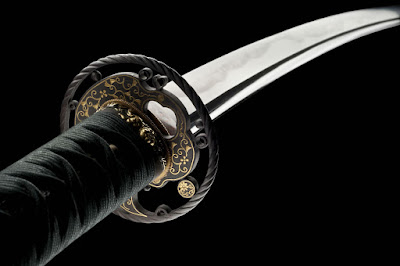The Katana was developed in the early 15th century, when the feudal era was brought to it's climax in what historians call "The Age of States at War." This era began when the Feudal lords of ancient Japan began fighting amongst one another for control of the land. This time in japanese history ended with the Meiji restoration, when Japan was restored to a unified country and swords were outlawed.
The katana was the samurai's most important sword. It is widely agreed that the Katana, or Dai-to is the single most perfect sword ever developed. It's power and finesse made it a nearly indefeatable weapon. Made with a curved ken (blade) set into a long tsuka (hilt) it is the sword we most identify with feudal japan today. The steel of the blade would be forged by master craftsmen, heated and folded over 200 times. Although the Katana was very powerful, it was also much lighter than European swords and could be handled with confidence and grace.
Most Katana are about 42" long from tip to pommel (the end of the hilt) and the blade is usually 26" to 28" long. This means that the tsuka itself can be up to 14" long, much shorter than the grips of it's predecessors, the No-Dachi and the Tachi.
The katana would be carried in a saya (scabbard> and tucked into the samurai's belt. Originally, they would carry the sword with the blade turned down. This was a more comfortable way for the armored samurai to carry his very long sword. The bulk of the samurai armor made it difficult to draw the sword from any other place on his body. When unarmored, samurai would carry their sword with the blade facing up. This made it possible to draw the sword and strike in one quick motion, usually beheading the opponent. In order to draw the sword, the samurai would turn the saya downward ninety degrees and pull it out of his belt just a bit with his left hand, then gripping the tsuka with his right hand he would slide it out while sliding the saya back to it's original position.
The appropriate way to hold the katana is still taught today by many schools of martial arts. First, the samurai would grab the tsuka with his right hand directly below the tsuba, or cut guard, which would keep his hand from slipping onto the blade. Next, he would place the pommel, the very bottom of the tsuka, into the palm of his left hand. The left hand would then be wrapped around and turned vertical so that the sword's pommel would be halfway into his closed hand. This left a gap of anywhere from 6" to 8" between the warrior's hands which allowed for superior flexibility. Because of the space between the fighter's hands, the sword's master could easily cut horizontall, vertically and diagonally.
Also taught even in today's martial arts schools are the various kamae, or stances, which the samurai would take while training at his dojo. Here, wooden swords called bokuto or bokken were used so the students would not give one another lethal injuries. Later, the flexible bamboo shinai were developed, which would allow students to strike one another without cauing injury.
The katana had great importance outside of combat as well. Throughout the Era of States at War, the Samurai would never be without it. It was a symbol of his status as a warrior, his obedience of the code of bushido and his undying loyalty to his master. It was considered a great honour to receive such a sword from one's master or even one's ally.




No hay comentarios:
Publicar un comentario